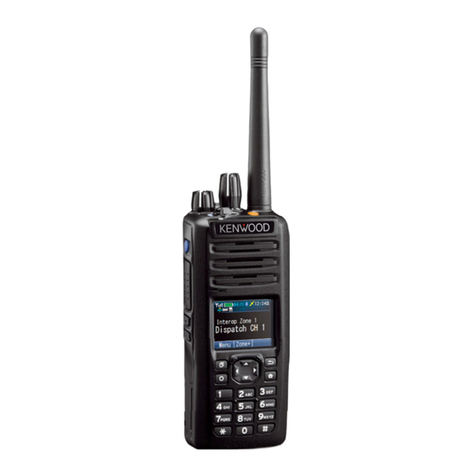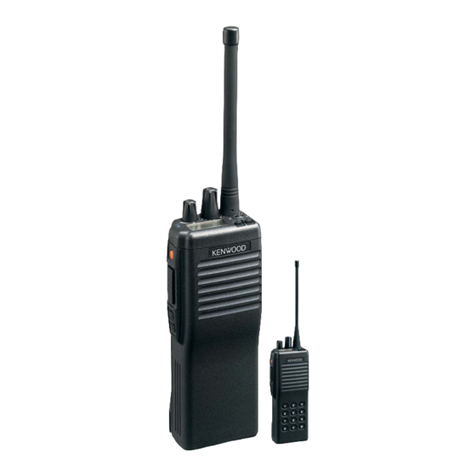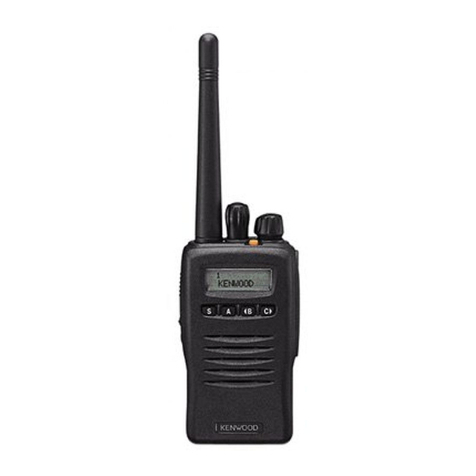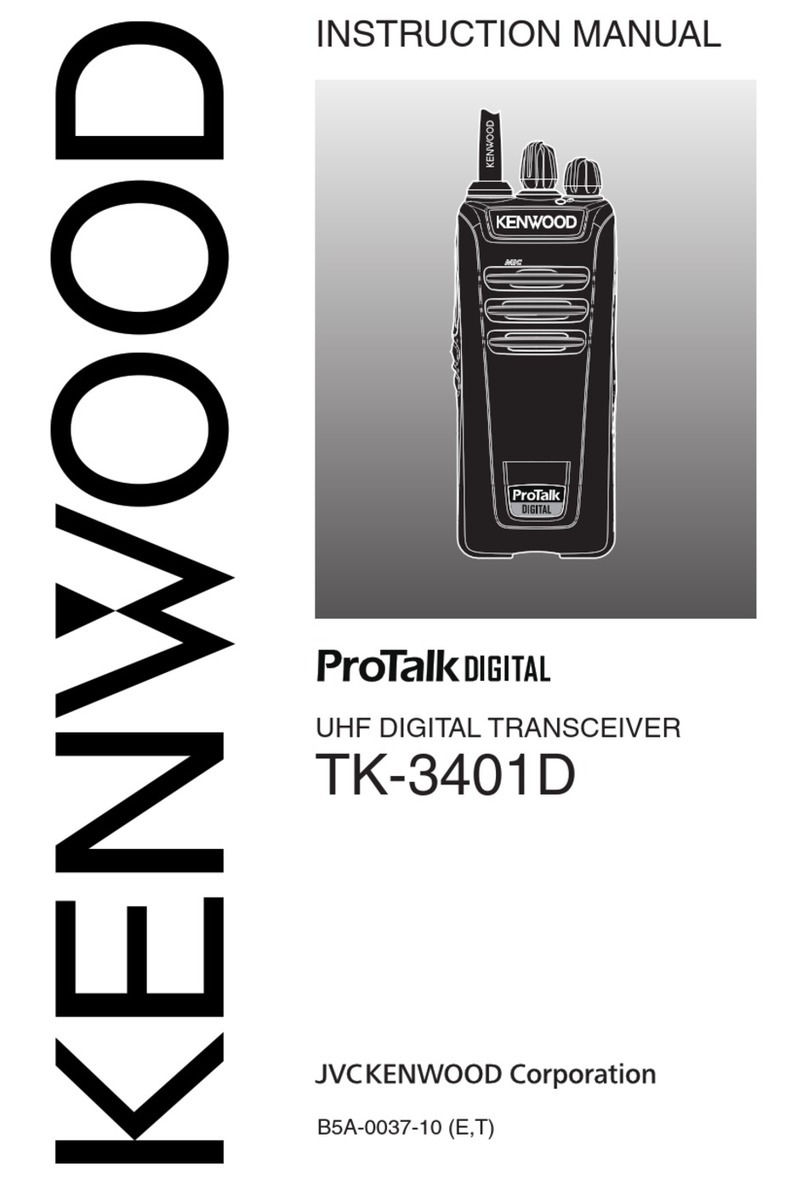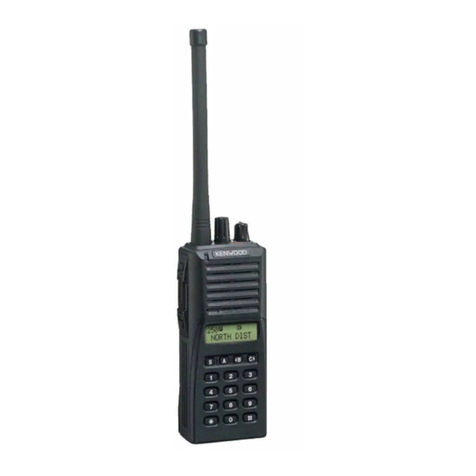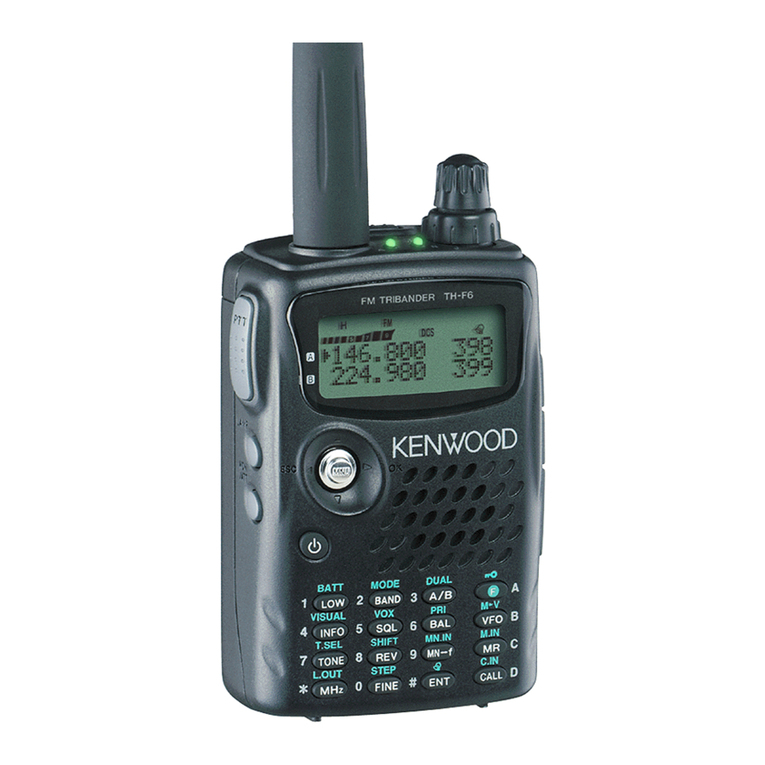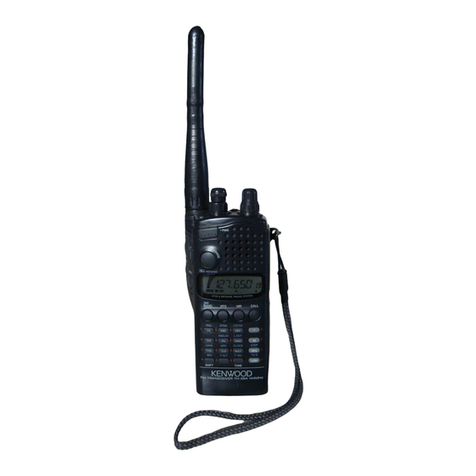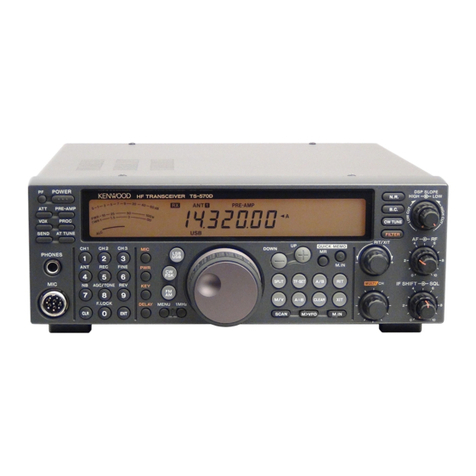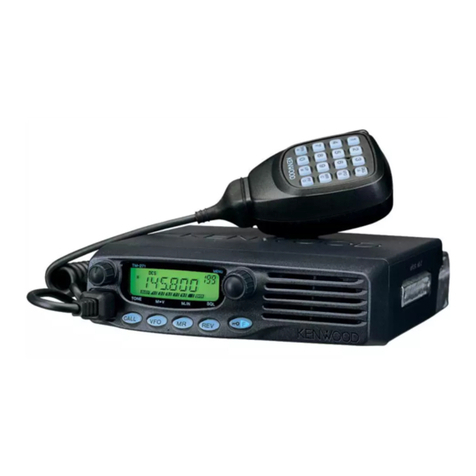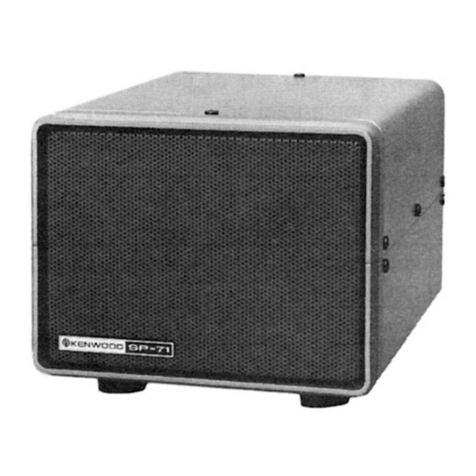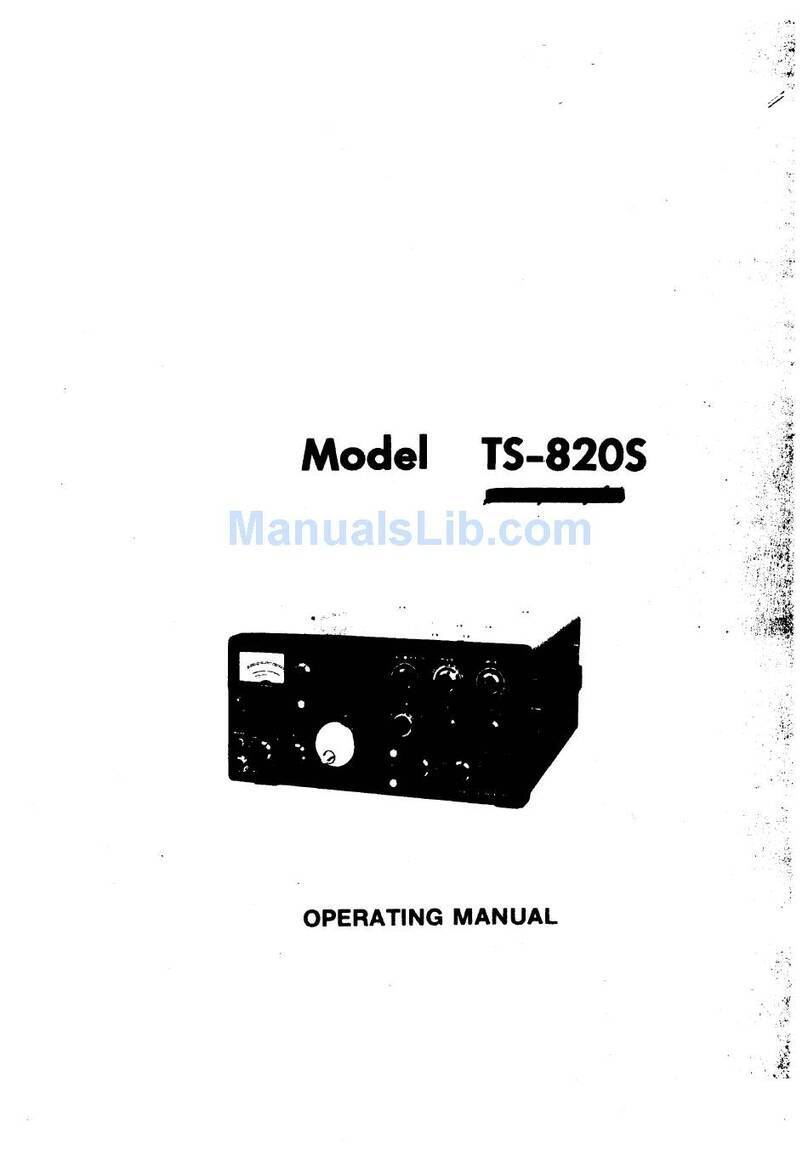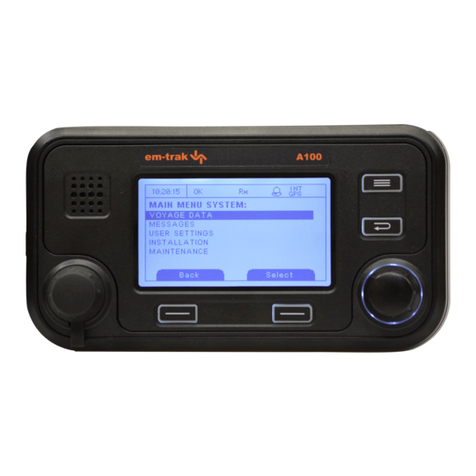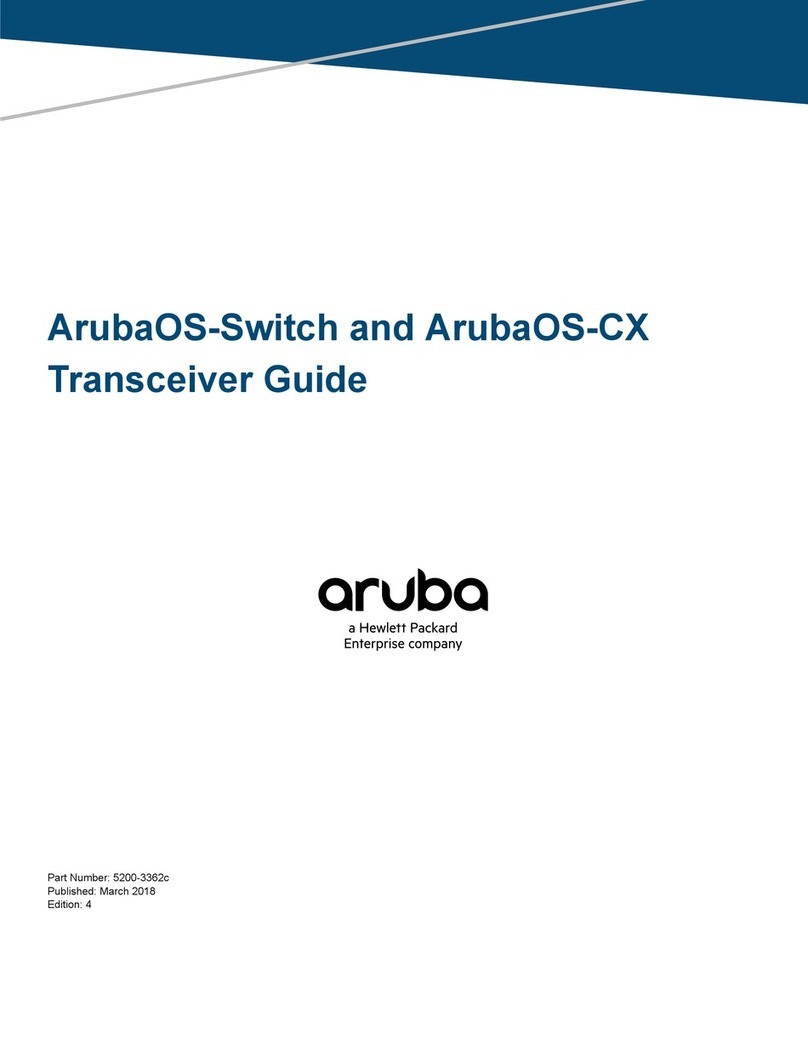
This User guide covers only the basic operations of your
radio. For using details instruction manual, refer to the
following URL or QR code.
https://manual.kenwood.com/files/B5K-0995-00.pdf
The AMBE+2™ voice coding Technology embodied in this product is protected by intellectual property
rights including patent rights, copyrights and trade secrets of Digital Voice Systems, Inc. This voice
coding Technology is licensed solely for use within this Communications Equipment. The user of this
Technology is explicitly prohibited from attempting to extract, remove, decompile, reverse engineer, or
disassemble the Object Code, or in any other way convert the Object Code into a human-readable form.
U.S. Patent Nos. #7,970,606, #8,359,197, #8,315,860, and #8,595,002.
Firmware Copyrights
The title to and ownership of copyrights for firmware embedded in KENWOOD product memories are
reserved for JVCKENWOOD Corporation.
NOTICES TO THE USER
◆Government law prohibits the operation of unlicensed radio transmitters within the territories under
government control.
◆Illegal operation is punishable by ne and/or imprisonment.
◆Refer service to qualied technicians only.
Safety: It is important that the operator is aware of, and understands, hazards common to the operation of
any transceiver.
WARNING
◆EXPLOSIVE ATMOSPHERES (GASES, DUST, FUMES, etc.)
Turn OFF your transceiver while taking on fuel or while parked in gasoline service stations. Do not
carry spare fuel containers in the trunk of your vehicle if your transceiver is mounted in the trunk
area.
◆INJURY FROM RADIO FREQUENCY TRANSMISSIONS
Do not operate your transceiver when somebody is either standing near to or touching the antenna,
to avoid the possibility of radio frequency burns or related physical injury.
◆DYNAMITE BLASTING CAPS
Operating the transceiver within 500 feet (150 m) of dynamite blasting caps may cause them to
explode. Turn OFF your transceiver when in an area where blasting is in progress, or where “TURN
OFF TWO-WAY RADIO” signs have been posted. If you are transporting blasting caps in your
vehicle, make sure they are carried in a closed metal box with a padded interior. Do not transmit
while the caps are being placed into or removed from the container.
One or more of the following statements may be applicable:
FCC WARNING
This equipment generates or uses radio frequency energy. Changes or modifications to this equipment
may cause harmful interference unless the modifications are expressly approved by the party responsible/
JVCKENWOOD. The user could lose the authority to operate this equipment if an unauthorized change or
modification is made.
INFORMATION TO THE DIGITAL DEVICE USER REQUIRED BY THE FCC
This equipment has been tested and found to comply with the limits for a Class B digital device, pursuant
to Part 15 of the FCC Rules. These limits are designed to provide reasonable protection against harmful
interference in a residential installation.
This equipment generates, uses and can generate radio frequency energy and, if not installed and used in
accordance with the instructions, may cause harmful interference to radio communications. However, there
is no guarantee that the interference will not occur in a particular installation. If this equipment does cause
harmful interference to radio or television reception, which can be determined by turning the equipment off
and on, the user is encouraged to try to correct the interference by one or more of the following measures:
• Reorient or relocate the receiving antenna.
• Increase the separation between the equipment and receiver.
• Connect the equipment to an outlet on a circuit different from that to which the receiver is connected.
• Consult the dealer for technical assistance.
This device contains licence-exempt transmitter(s)/receiver(s) that comply with Innovation, Science
and Economic Development Canada’s licence-exempt RSS(s). Operation is subject to the following two
conditions:
1. This device may not cause interference.
2. This device must accept any interference, including interference that may cause undesired operation of
the device.
(NX-5000/ NX-3000 series)
SUPPLIER'S DECLARATION OF CONFORMITY
47 CFR § 2.1077 Compliance Information
Trade name: KENWOOD
Model(s): NX-5000 series, NX-3000 series, NX-1000 series
Responsible party: JVCKENWOOD USA Corporation 1440 Corporate Drive, Irving, TX 75038
Telephone number: 972-819-0700
This device complies with part 15 of the FCC Rules. Operation is subject to the following two conditions: (1) This device
may not cause harmful interference, and (2) this device must accept any interference received, including interference
that may cause undesired operation.
PRECAUTIONS
Observe the following precautions to prevent fire, personal injury, and transceiver damage.
• Do not attempt to configure the transceiver while driving; it is too dangerous.
• Do not disassemble or modify the transceiver for any reason.
• Do not expose the transceiver to long periods of direct sunlight, nor place it near heating appliances.
• If an abnormal odor or smoke is detected coming from the transceiver, switch the transceiver power off
immediately, and contact your KENWOOD dealer.
• Use of the transceiver while you are driving may be against traffic laws. Please check and observe the
vehicle regulations in your area.
• Do not use options not specified by KENWOOD.
• Do not put the plastic bag used for packing of this equipment on the place which reaches a small
child's hand. It will become a cause of suffocation if it wears flatly.
• Do not place the transceiver on unstable surfaces.
• Keep the volume as low as possible to protect your hearing.
• Always switch the transceiver power off before installing optional accessories.
• To dispose of built-in battery, be sure to comply with the laws and regulations in your country or region.
• JVCKENWOOD Corporation shall be free from any responsibilities for any incidental losses or
damages, such as missing communications or call opportunities caused by a failure or performance
error of the transceiver.
• If condensation forms, let it air dry or leave it in the same environment for a long time to eliminate the
condensation before using it.
WARNING
◆For passenger safety, install the transceiver securely using the supplied or optional mounting bracket
and screw set so the transceiver will not break loose in the event of a collision.
CAUTION
◆The transceiver operates in 12 V negative ground systems only! Check the battery polarity and
voltage of the vehicle before installing the transceiver.
◆Use only the supplied DC power cable or a KENWOOD optional DC power cable.
◆Do not cut and/or remove the fuse holder on the DC power cable.
◆Do not place the microphone cable around your neck while near machinery that may catch the cable.
◆When replacing the fuse in the DC power cable, be sure to replace it with a fuse of the same value.
Never replace a fuse with a fuse that has a higher value.
HOT SURFACE
◆Do not touch the metal surface of the transceiver while it is in use.
Do not mount the transceiver such that the chassis can come in
contact with skin.
High temperatures may burn your skin.
SD™ and microSD™ are trademarks of SD-3C, LLC in the United States and/or other countries.
The Bluetooth®word mark and logos are registered trademarks owned by Bluetooth SIG, Inc. and any use
of such marks by JVCKENWOOD Corporation is under license. Other trademarks and trade names are
those of their respective owners.
VHF/UHF TRANSCEIVER
USER GUIDE
NX-5000 series
NX-3000 series
NX-1000 series
MANDATORY SAFETY INSTRUCTIONS TO INSTALLERS AND USERS
• Use only manufacturer or dealer supplied antenna.
• Antenna Minimum Safe Distance: Refer to the values in the table below.
• Antenna Gain: 0dBd referenced to a dipole.
The Federal Communications Commission has adopted a safety standard for human exposure to RF (Radio
Frequency) energy which is below the OSHA (Occupational Safety and Health Act) limits.
• Antenna Mounting: The antenna supplied by the manufacturer or radio dealer must not be mounted
at a location such that during radio transmission, any person or persons can come closer than the
minimum safe distance indicated in the table below.
• To comply with current FCC/ ISED RF Exposure limits, the antenna must be installed at or exceeding
the minimum safe distance shown above, and in accordance with the requirements of the antenna
manufacturer or supplier.
• Vehicle installation: The antenna can be mounted at the center of a vehicle metal roof or trunk lid, if
the minimum safe distance is observed.
• Base Station Installation: The antenna should be fixed-mounted on an outdoor permanent structure.
RF Exposure compliance must be addressed at the time of installation.
Antenna substitution: Do not substitute any antenna for the one supplied or recommended by the
manufacturer or radio dealer.
You may be exposing person or persons to excess radio frequency radiation.You may contact your radio
dealer or the manufacturer for further instructions.
WARNING
Maintain a separation distance from the antenna to person(s) of at least the distance indicated in the table
below.
You, as the qualified end-user of this radio device must control the exposure conditions of bystanders to
ensure the minimum separation distance (table below) is maintained between the antenna and nearby
persons for satisfying RF Exposure compliance. The operation of this transmitter must satisfy the
requirements of Occupational/Controlled Exposure Environment, for work-related use, transmit only when
person(s) are at least the minimum distance from the properly installed, externally mounted antenna.
Transmit only when people outside the vehicle are at least the recommended minimum lateral distance
away from the antenna/vehicle.
Antenna Minimum Safe Distance
Frequeny Range Rated Power Safe Distance
VHF 50 W 170 cm (5.6 feet)
110 W 240 cm (7.9 feet)
UHF 45 W 140 cm (4.6 feet)
100 W 160 cm (5.3 feet)
700/800 MHz 30 W 100 cm (3.3 feet)
800/900 MHz 15 W 70 cm (2.3 feet)
“This transmitter is authorized to operate with a maximum duty factor of 50%, in typical push-to-talk mode,
for satisfying FCC/ ISED RF exposure compliance requirements.”
© 2022
B5A-4028-00 (K)





